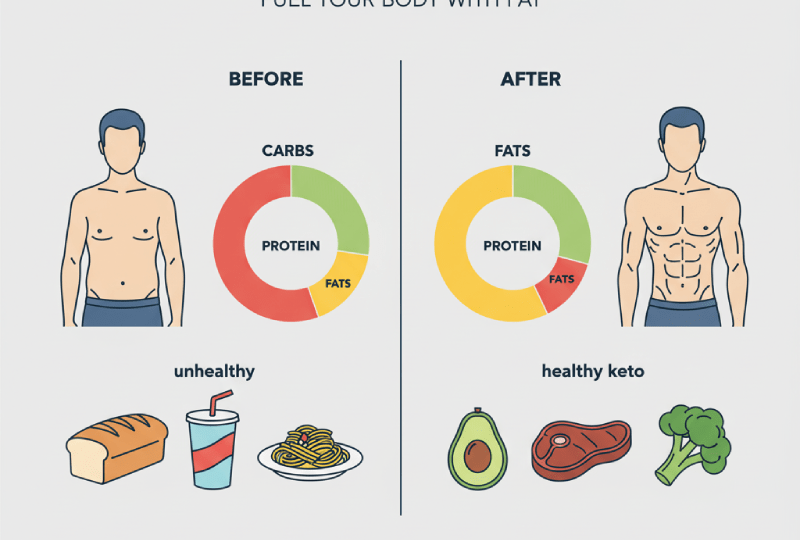What is the Ketogenic Diet?
The ketogenic diet is a very low-carbohydrate, high-fat, and moderate-protein eating plan that aims to trigger a metabolic state called ketosis. Normally, our bodies use glucose, or carbohydrates, for energy. However, when carbohydrate intake is severely restricted, the body begins to use fats for fuel. The liver converts fatty acids into ketone bodies, and these ketones become the primary energy source for our brain and body. This state is called ketosis.
The history of the ketogenic diet actually dates back to the 1920s. It was initially developed and used to control seizures in epilepsy patients. Since then, it has become a popular method for weight loss, management of type 2 diabetes, and various other health conditions. The basic principle of the diet is to radically change the macronutrient distribution: typically, 70-80% of daily calories come from fat, 15-20% from protein, and only 5-10% from carbohydrates. This ratio naturally shifts the body into a fat-burning mode.
How Does Ketosis Work?
Our bodies convert the carbohydrates we eat into glucose. Glucose enters the bloodstream and, with the help of the hormone insulin, is transported to cells to be used for energy or stored as glycogen in the liver and muscles. Since carbohydrate intake is dramatically reduced on the ketogenic diet, glucose levels drop and the body’s glycogen stores are depleted. This prompts the body to find a new source of energy.
After about 3-4 days, the body enters ketosis. The liver begins to burn fatty acids and produces three main types of ketone bodies in the process: acetoacetate, beta-hydroxybutyrate (BHB), and acetone. BHB is considered the most efficient type of ketone for the body and is thought to be an even better energy source for both the brain and other organs than glucose. The state of ketosis can be measured with blood, urine, or breath tests.
Another important effect of ketosis is the drop in insulin levels. Low insulin levels allow the body’s fat stores to be broken down more easily and used for energy. This is one of the main reasons why the ketogenic diet is so effective for weight loss. When the body uses stored fats as its primary fuel, fat burning accelerates.
Types of Ketogenic Diets
The ketogenic diet can be implemented in several different ways to suit various lifestyles and goals:
- Standard Ketogenic Diet (SKD): This is the most common and well-researched type. It typically consists of 75% fat, 20% protein, and 5% carbohydrates. It is suitable for most people who want to lose weight or improve their general health.
- Cyclical Ketogenic Diet (CKD): This approach involves periods of higher carbohydrate intake. For example, after following the ketogenic diet for 5-6 days, a high-carbohydrate diet is followed for 1-2 days. This can be beneficial for athletes and those who train intensely, as it helps to replenish glycogen stores.
- Targeted Ketogenic Diet (TKD): This type of diet allows for the consumption of carbohydrates before or after exercise. Typically, 20-30 grams of easily digestible carbohydrates are consumed about 30 minutes before a workout. This helps athletes improve their training performance while still aiming to maintain a state of ketosis.
- High-Protein Ketogenic Diet: Similar to the standard keto diet, but it includes more protein. The ratios are typically 60% fat, 35% protein, and 5% carbohydrates. This diet is popular among bodybuilders and athletes who are trying to preserve and increase muscle mass.
What to Eat on a Ketogenic Diet?
The foundation of a ketogenic diet consists of healthy fats, moderate protein, and low-carb vegetables. Here are some foods that can be consumed on a ketogenic diet:
Healthy Fats:
- Avocado and avocado oil
- Olive oil
- Coconut oil and MCT oil
- Butter and ghee
- Fatty fish (salmon, mackerel, sardines)
- Nuts and seeds (almonds, walnuts, chia seeds, flax seeds)
Protein Sources:
- Red meat (beef, lamb)
- Poultry (chicken, turkey)
- Fish and seafood
- Eggs
- Cheese and full-fat yogurt
Low-Carb Vegetables:
- Leafy greens (spinach, lettuce, kale)
- Broccoli, cauliflower, Brussels sprouts
- Zucchini, cucumber, asparagus
- Mushrooms, peppers
- Onions and garlic (in moderation)
What to Avoid on a Ketogenic Diet?
The success of the ketogenic diet depends on avoiding high-carbohydrate foods. The following foods should be strictly avoided on a ketogenic diet:
- Sugary Foods: Soft drinks, fruit juices, sweets, ice cream, cakes, cookies.
- Grains and Starchy Foods: Bread, pasta, rice, corn, oats, potatoes.
- Fruits: Most fruits are high in sugar. Low-carb fruits (strawberries, raspberries, blueberries) can be consumed in moderation.
- Legumes: Beans, lentils, chickpeas, peas.
- Certain Fats: Margarine, processed vegetable oils.
- Alcohol: Beer and some wines are high in carbohydrates.
- Sugary Sauces: Sugary sauces like ketchup and barbecue sauce should be avoided.
Potential Benefits of the Ketogenic Diet
Beyond weight loss, the ketogenic diet offers many potential health benefits:
- Weight Loss: It provides rapid and effective weight loss because the body starts burning its fat stores. The high-fat content of the diet increases feelings of fullness, leading to less hunger.
- Blood Sugar Control: The reduction in carbohydrate intake lowers blood sugar and insulin levels. This can be beneficial for people with type 2 diabetes and can reduce insulin resistance.
- Neurological Health: The ketogenic diet improves the brain’s energy metabolism, and ketones are thought to have anti-inflammatory and neuroprotective effects. This may help alleviate symptoms of neurological diseases like epilepsy, Alzheimer’s, and Parkinson’s.
- Polycystic Ovary Syndrome (PCOS): PCOS is linked to insulin resistance. The ketogenic diet can help alleviate PCOS symptoms by lowering insulin levels and promoting weight loss.
- Heart Health: Some studies show that the ketogenic diet can improve cholesterol profiles, raising levels of good cholesterol (HDL) and lowering triglycerides.
- Acne and Skin Health: The diet may be beneficial for skin problems like acne by regulating insulin levels.
Potential Risks and Side Effects
The ketogenic diet has some potential side effects and risks, especially in the initial stages of the diet:
- “Keto Flu”: This is a set of symptoms that appear when starting the diet. These include headache, fatigue, nausea, dizziness, irritability, and difficulty concentrating. These symptoms usually pass within a few days and are due to the body adapting to ketosis.
- Nutrient Deficiencies: The restriction of many healthy, carbohydrate-containing foods (fruits, certain vegetables, and whole grains) can lead to vitamin and mineral deficiencies. Potassium, magnesium, and calcium deficiencies, in particular, can be common.
- Kidney Stone Formation: High protein intake and changes in urinary pH can increase the risk of kidney stones.
- Digestive Problems: The reduced intake of high-fiber foods (whole grains, some fruits) can lead to digestive issues like constipation.
- Long-Term Effects: More research is needed on the long-term health effects of the ketogenic diet. Some concerns are related to the high intake of saturated fats, which could increase the risk of heart disease.
Tips for Starting a Ketogenic Diet
If you are considering starting a ketogenic diet, you can follow these tips to make the transition easier:
- Do Your Research and Plan: Before starting the diet, clearly determine what you will eat and what you will avoid. Preparing a few sample daily menus can help keep you motivated.
- Pay Attention to Electrolyte Intake: To minimize “keto flu” symptoms, make sure you are getting enough sodium, potassium, and magnesium. Drinking saltwater and consuming avocados and leafy greens can help.
- Drink Plenty of Water: Hydration is very important. Dehydration can worsen symptoms like headaches and fatigue.
- Be Prepared: Having low-carb snacks at home prevents you from straying from the diet in moments of crisis. Options like almonds, walnuts, cheese, and olives are ideal.
- Count Your Carbs: Tracking your daily net carb (total carbs – fiber) intake helps you stay in ketosis.
- Seek Professional Advice: It is always best to consult a doctor or nutritionist before starting any dietary change. This is even more crucial if you have a chronic illness.
Who Should Try the Ketogenic Diet and Who Should Avoid It?
Who is it suitable for:
- People who want to lose weight
- People with type 2 diabetes who want to control their blood sugar and insulin resistance
- People with neurological conditions like epilepsy (under medical supervision)
- People with certain metabolic diseases
Who is it not suitable for:
- Pregnant or breastfeeding women
- People with pancreas, liver, gallbladder, or thyroid problems
- People with a history of eating disorders
- People who use diabetes medication without professional supervision (due to the risk of hypoglycemia)
Conclusion
When implemented correctly, the ketogenic diet can be an effective tool for weight loss and health improvement. It works by shifting the body from a carbohydrate-burning mode to a fat-burning mode, and this process can provide many benefits, from blood sugar control to neurological health. However, it also comes with potential side effects like the “keto flu” and the risk of nutrient deficiencies. Conducting comprehensive research and consulting a healthcare professional before starting the diet is vital for a safe and successful experience. Sustainability, as with any diet, is the key to success on the ketogenic diet.



